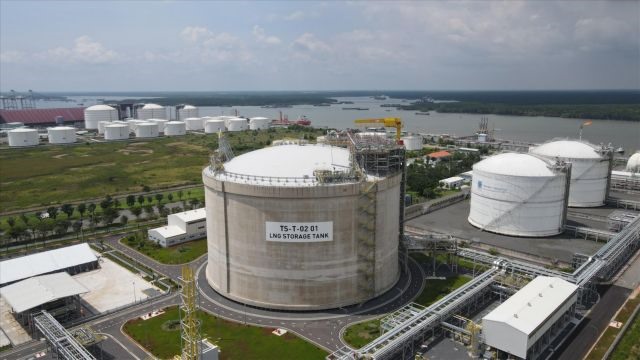 |
The Thị Vải LNG Storage Complex in the southern province of Bà Rịa-Vũng Tàu. VNA/VNS Photo
HÀ NỘI Industry leaders and economists discussed current challenges and proposed solutions for the development of Việt Nam’s liquefied natural gas (LNG) sector during a workshop yesterday in Hà Nội.
Economist Trần Đình Thiên said the sector has much untapped potential as the country aims to integrate LNG into its energy sector, which will contribute significantly to national energy security, uphold international commitments, and serve the population and the government’s economic development agenda. However, he said existing challenges and obstacles must be overcome to transform that potential into reality.
Nguyễn Quốc Thập, chairman of the Vietnam Petroleum Association (VPA), said while there is vast potential for investing in LNG development, the absence of necessary legal frameworks and pricing structures has been hindering the sector.
He stressed the importance of addressing these issues to expedite Việt Nam’s LNG development agenda in 2024, aligning with the government’s Power Plan VIII objectives.
Economist Đinh Trọng Thịnh said Việt Nam has set an ambitious goal for the sector with a plan to construct as many as 13 new LNG power plants with a combined capacity of 22,400MW by 2030. An additional two plants with a capacity of 3,000MW are planned for 2035. Currently, 13 approved investment projects for LNG power plants are in progress, with five actively advancing, four looking for investors, and the remaining four under consideration by local authorities.
He said, however, that the real challenge lies in the realisation that an LNG power project typically spans over eight years, posing a significant hurdle to achieving the plan of constructing 13 new LNG power plants by 2030.
Economists and industry insiders have long called for measures to address the country’s infrastructure and policy-related issues to meet objectives set in the Power Plan VIII.
Firstly, comprehensive planning, with a focus on LNG import port projects, was deemed necessary to conserve social resources, drive economic development and stimulate the domestic LNG market. Investors require well-thought-out plans for ports, liquefaction facilities, pipeline systems and gas power plants to assess their capital investments.
Secondly, there was an urgent need for the government to enhance the legal framework as a basis for deploying LNG-related infrastructure. This includes regulations, technical standards and financial standards. Clear, feasible and practical policy mechanisms are essential for effective management and regulation, along with establishing a distribution system to access the market and promote international cooperation. A robust legal foundation is imperative to attract investments into LNG power projects.
During the workshop, Thịnh proposed the construction of modern LNG ports meeting international standards at strategic locations capable of accommodating large LNG carriers, ensuring absolute safety and port security.
Meanwhile, Việt Nam must build a comprehensive storage and distribution system for LNG, along with establishing liquefaction facilities in consumption areas as investors must rely on these plans to inject capital into building infrastructure and gas power plants, unlocking Việt Nam’s potential in the LNG sector. VNS
- Reduce Hair Loss with PURA D’OR Gold Label Shampoo
- Castor Oil Has Made a “Huge” Difference With Hair and Brow Growth
- Excessive hair loss in men: Signs of illness that cannot be subjective
- Dịch Vụ SEO Website ở Los Angeles, CA: đưa trang web doanh nghiệp bạn lên top Google
- Nails Salon Sierra Madre
 VnExpress News The News Gateway of Vietnam
VnExpress News The News Gateway of Vietnam




